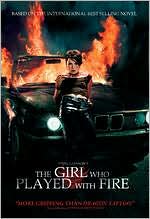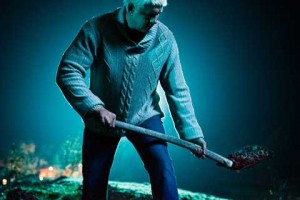“This girl has problems, no?”
The seco nd film from the Millenium Trilogy of novels by Stieg Larsson, The Girl Who Played with Fire, like its predecessor, The Girl with the Dragon Tattoo, hews closely to the plot line of the novel. Without any introduction, the life story of Lisbeth Salander continues where it left off, as she tries to navigate a world which damaged her to the point that she has difficulty relating to all humans. This film features the same cast in the lead roles as The Girl with the Dragon Tattoo though both the director and the cinematographers have changed. Lisbeth Salander (Noomi Rapace), a computer hacker extraordinaire, has returned from a year of traveling the world, during which time Mikael Blomqvist (Michael Nyqvist), publisher of Millenium magazine, moved on with his life. Millenium Magazine is investigating the sex trade and its relationship to the drug trade, and a young freelancer who has been hired by Millenium has uncovered evidence that officials at the highest levels of the legal and political system are involved.
nd film from the Millenium Trilogy of novels by Stieg Larsson, The Girl Who Played with Fire, like its predecessor, The Girl with the Dragon Tattoo, hews closely to the plot line of the novel. Without any introduction, the life story of Lisbeth Salander continues where it left off, as she tries to navigate a world which damaged her to the point that she has difficulty relating to all humans. This film features the same cast in the lead roles as The Girl with the Dragon Tattoo though both the director and the cinematographers have changed. Lisbeth Salander (Noomi Rapace), a computer hacker extraordinaire, has returned from a year of traveling the world, during which time Mikael Blomqvist (Michael Nyqvist), publisher of Millenium magazine, moved on with his life. Millenium Magazine is investigating the sex trade and its relationship to the drug trade, and a young freelancer who has been hired by Millenium has uncovered evidence that officials at the highest levels of the legal and political system are involved.

Rapace as Lisbeth and Nyqvist as Blomqvist had remarkable chemistry in The Girl with the Dragon Tattoo, but they are rarely in the same scene in this film. Like the book, this film is Lisbeth’s story, and as her background unfolds, the reader comes to know how and why she was institutionalized and why she is so damaged. Like the book, also, this film is weaker than its predecessor, though lovers of the trilogy will still find it fun to watch. Some nudity, horrific violence, and explicit sex also appear here, as they did in the previous film. Though this is a bloodier film, it seems somehow less dramatic, more formulaic.
With its change of director and cinematographers, this film lacks the icy sparkle and brittle atmosphere of The Girl with the Dragon Tattoo. The scenes in this film are as dark as they were in that film, but the sharp visual contrasts and dramatic changes of lighting, which added to the suspense and mood in the first film, are missing here. It becomes more of an action film than an intense character-based study filled with menace, mood, and almost palpable suspense, and it is less coherent than the previous film.
Two characters, Ronald Niedermann (played by Micke Spreitz), the sadistic giant who cannot feel pain, and Holger Palmgren (played by Per Oscarsson), the man who was Lisbeth’s early and much admired guardian before he was replaced by Nils Bjurmann, add special drama to the film, the first because he is so terrifying, and the second because he seems so needy and so honorable. Unfortunately, Holger Palmgren, who is known to readers of the novel, is not clearly identified in this film, and newcomers to the series will have little, if any, idea who he is, when he appears, or what his role has been in Lisbeth’s past life.

Those who enjoyed the book will probably also like the film. It is not as moody or atmospheric as the first film, and it is loose in its construction (as was the novel), but it moves the story line along so that those who see it will probably be anxious to see the final film installment, The Girl Who Kicked the Hornet’s Nest.
Notes: The photos of Blomqvist, Niedermann, and Lisbeth Salander are all stills from the film which appear on http://www.allmoviephoto.com
The trailer for this film is here:
